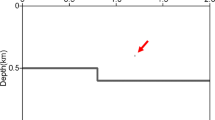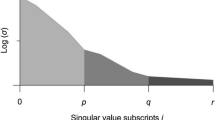Abstract
Diffractions with good illumination carry valuable subwavelength information below the Rayleigh limit and can be used for high-resolution imaging of small-scale discontinuous features. As diffractions are characterized by weak energy, diffracted wavefield separation is a key step before imaging of discontinuities. The traditional multichannel singular-spectrum analysis (MSSA) for diffraction separation considers the constant rank strategy. It is challenging to estimate the appropriate rank for various data. In this study, we propose a robust adaptive rank-reduction method for 3D diffraction separation and imaging. It utilizes the low-rank characteristics of reflections in the common-offset or poststack domain based on the MSSA algorithm. The method considers the kinematic and dynamic differences of reflections and diffractions, and combines the energy intensity and smoothed curvature to accurately estimate the rank thresholds as well as the ranks of the reflections and diffractions. Three-dimensional multilayer and complex synthetic examples are used to demonstrate the feasibility of the proposed method in removing reflections and separating diffractions and achieving high-resolution imaging with diffractions, which is helpful for seismic data interpretation.
















Similar content being viewed by others
References
Bansal, R., & Imhof, M. G. (2005). Diffraction enhancement in prestack seismic data. Geophysics, 70, V73–V79.
Bekara, M., & van der Baan, M. (2007). Local singular value decomposition for signal enhancement of seismic data. Geophysics, 72, V59–V65.
Berkovitch, A., Belfer, I., Hassin, Y., & Landa, E. (2009). Diffraction imaging by multifocusing. Geophysics, 74, WCA75–WCA81.
Carrion, P. M. (1990). Enhanced migration of seismic data. Geophysical Prospecting, 38, 689–704.
Chen, Y. K., Huang, W. L., Zhang, D., & Chen, W. (2016). An open-source Matlab code package for improved rank-reduction 3D seismic data denoising and reconstruction. Computers & Geosciences, 95, 59–66.
Claerbout, J. F. (1992). Earth soundings analysis: processing versus inversion. Blackwell Scientific Publications Inc.
Cui, H. X., Zhang, L. B., & Kang, R. Y. (2009). Research on fault diagnosis for reciprocating compressor valve using energy entropy and SVM method. Journal of Loss Prevention in the Process Industries, 22, 864–867.
Decker, L., Merzlikin, D., & Fomel, S. (2017). Diffraction imaging and time-migration velocity analysis using oriented velocity continuation. Geophysics, 82, U25–U35.
Dell, S., & Gajewski, D. (2011). Common-reflection-surface-based workflow for diffraction imaging. Geophysics, 76, S187–S195.
Etgen, J., Gray, S., & Zhang, Y. (2009). An overview of depth imaging in exploration geophysics. Geophysics, 74, WCA5–WCA17.
Fomel, S. (2002). Application of plane-wave destruction filters. Geophysics, 67, 1946–1960.
Fomel, S., Landa, E., & Taner, M. T. (2007). Poststack velocity analysis by separation and imaging of seismic diffractions. Geophysics, 72, U89–U94.
Gan, S. W., Chen, Y. K., Zu, S. H., Qu, S., & Zhong, W. (2015). Structure-oriented singular value decomposition for random noise attenuation of seismic data. Journal of Geophysics and Engineering, 12, 262–272.
Golub, G. H., & Loan, C. F. V. (1996). Matrix computations (3rd ed.). John Hopkins University Press.
He, X. C., & Yung, N. H. C. (2008). Corner detector based on global and local curvature properties. Optical Engineering, 47, 057008.
Huang, J., Hu, X. G., & Geng, X. (2011). An intelligent fault diagnosis method of high voltage circuit breaker based on improved EMD energy entropy and multi-class support vector machine. Electric Power Systems Research, 81, 400–407.
Huang, W. L., Wang, R. Q., Yuan, Y., Gan, S. W., & Chen, Y. K. (2017). Signal extraction using randomized-order multichannel singular spectrum analysis. Geophysics, 82, V59–V74.
Kanasewich, E. R., & Phadke, S. M. (1988). Imaging discontinuities on seismic sections. Geophysics, 53, 334–345.
Keller, J. B. (1962). Geometrical theory of diffraction. Journal of the Optical Society of America, 52, 116–130.
Klem-Musatov, K. (1994). Theory of seismic diffractions. SEG.
Klem-Musatov, K., & Aizenberg, A. (1984). The ray method and the theory of edge waves. Geophysical Journal International, 79, 35–50.
Klokov, A., Baina, R., Landa, E., Thore, P., Tarrass, I. (2010) Diffraction imaging for fracture detection: Synthetic case study: 80th Annual International Meeting, SEG, Expanded Abstracts, 3354–3358.
Klokov, A., & Fomel, S. (2012). Separation and imaging of seismic diffractions using migrated angle gathers. Geophysics, 77, S131–S143.
Kunz, B. F. J. (1960). Diffraction problems in fault interpretation. Geophysical Prospecting, 8, 381–388.
Landa, E., Fomel, S., Reshef, M. (2008) Separation, imaging, and velocity analysis of seismic diffractions using migrated angle gathers: 78th Annual International Meeting, SEG, Expanded Abstracts, 2176–2180.
Landa, E., & Keydar, S. (1998). Seismic monitoring of diffraction images for detection of local heterogeneities. Geophysics, 63, 1093–1100.
Landa, E., Shtivelman, V., & Gelchinsky, B. (1987). A method for detection of diffracted waves on common-offset sections. Geophysical Prospecting, 35, 359–374.
Li, Z., & Zhang, J. (2020). Imaging 3-D faults using diffractions with modified dip-angle gathers. Geophysical Journal International, 220, 1569–1584.
Lin, P., Peng, S. P., Wu, R.S., Zhao, J. T., Cui, X. Q., Wu, X. M. (2019) 3D diffraction separation and imaging using an adaptive rank-reduction method: 89th Annual International Meeting, SEG, Expanded Abstracts, 4221–4225.
Lin, P., Peng, S. P., Zhao, J. T., & Cui, X. Q. (2020). Diffraction separation and imaging using multichannel singular-spectrum analysis. Geophysics, 85, V11–V24.
Lin, P., Peng, S. P., Zhao, J. T., Cui, X. Q., & Du, W. F. (2018b). Accurate diffraction imaging for detecting small-scale geologic discontinuities. Geophysics, 83, S447–S457.
Lin, P., Peng, S. P., Zhao, J. T., Cui, X. Q., & Wang, H. H. (2018a). L1-norm regularization and wavelet transform: an improved plane-wave destruction method. Journal of Applied Geophysics, 148, 16–22.
Liu, C., Song, C., & Lu, Q. (2017). Random noise de-noising and direct wave eliminating based on SVD method for ground penetrating radar signals. Journal of Applied Geophysics, 144, 125–133.
Liu, L., Vincent, E., Xu, J., Qin, F., & Yi, L. (2016). Imaging diffractors using wave-equation migration. Geophysics, 81, S459–S468.
Liu, Y., Fomel, S., & Liu, G. (2010). Nonlinear structure-enhancing filtering using plane-wave prediction. Geophysical Prospecting, 58, 415–427.
Lowney, B., Lokmer, I., O’Brien, G. S., Amy, L., Bean, C. J., & Igoe, M. (2020). Enhancing interpretability with diffraction imaging using plane-wave destruction aided by frequency-wavenumber f-k filtering. Interpretation, 8, 1–52.
Moser, T. J., & Howard, C. B. (2008). Diffraction imaging in depth. Geophysical Prospecting, 56, 627–641.
Oropeza, V., & Sacchi, M. (2011). Simultaneous seismic data denoising and re-construction via multichannel singular spectrum analysis. Geophysics, 76, V25–V32.
Rad, P. B., Schwarz, B., Gajewski, D., & Vanelle, C. (2018). Common-reflection-surface-based prestack diffraction separation and imaging. Geophysics, 83, S47–S55.
Reshef, M. (2007). Velocity analysis in the dip-angle domain: 69th Annual International Conference and Exhibition, EAGE, Extended Abstracts, C002.
Reshef, M., & Landa, E. (2009). Post-stack velocity analysis in the dip-angle domain using diffractions. Geophysical Prospecting, 57, 811–821.
Schwarz, B. (2019). Coherent wavefield subtraction for diffraction separation. Geophysics, 84, V157–V168.
Schwarz, B., & Gajewski, D. (2017). Accessing the diffracted wavefield by coherent subtraction. Geophysical Journal International, 211, 45–49.
Schwarz, B., & Krawczyk, C. M. (2020). Coherent diffraction imaging for enhanced fault and fracture network characterization. Solid Earth Discussions, 11, 1891–1907.
Schwarz, B., Vanelle, C., Gajewski, D., & Kashtan, B. (2014). Curvatures and inhomogeneities: an improved common-reflection-surface approach. Geophysics, 79, S231-240.
Tschannen, V., Ettrich, N., Delescluse, M., & Keuper, J. (2020). Detection of point scatterers using diffraction imaging and deep learning. Geophysical Prospecting, 68, 830–844.
Yang, Y., Yu, D. J., & Cheng, J. S. (2006). A roller bearing fault diagnosis method based on EMD energy entropy and ANN. Journal of Sound and Vibration, 294, 269–277.
Yu, C. X., Wang, Y. F., & Zhao, J. T. (2017). A seismic diffraction extraction method for the study of discontinuous geologies using a regularization algorithm. Exploration Geophysics, 48, 49–55.
Zhao, J. T., Peng, S. P., Du, W. F., & Li, X. T. (2016). Diffraction imaging method by Mahalanobis-based amplitude damping. Geophysics, 81, S399–S440.
Zhao, J. T., Yu, C. X., Peng, S. P., & Li, C. J. (2020). 3D diffraction imaging method using low-rank matrix decomposition. Geophysics, 85, S1–S10.
Zheng, J., Peng, S. P., & Yang, F. (2014). A novel edge detection for buried target extraction after SVD-2D wavelet processing. Journal of Applied Geophysics, 106, 106–113.
Acknowledgements
This work is supported by National Natural Science Foundation of China (grant no. 42022031,41874157), National Key Research and Development Program of China (grant no. 2020YFE0201300), Fundamental Research Funds for the Central Universities (grant no. 2020YQMT01), the 111 project (erant no. B18052) and Open Fund of State Key Laboratory of Coal Resources and Safe Mining (grant no. SKLCRSM19KFA10). We are grateful to the discussion with Rushan Wu and Xiaobi Xie in the WTOPI group of the University of California, Santa Cruz. We would like to thank the Peng Research Group at the CUMTB for help and partial support of this work.
Author information
Authors and Affiliations
Corresponding author
Ethics declarations
Conflict of interest
The authors declared that they have no conflicts of interest to this work.
Additional information
Publisher's Note
Springer Nature remains neutral with regard to jurisdictional claims in published maps and institutional affiliations.
Rights and permissions
About this article
Cite this article
Lin, P., Zhao, J., Peng, S. et al. A Robust Adaptive Rank-Reduction Method for 3D Diffraction Separation and Imaging. Pure Appl. Geophys. 178, 2917–2931 (2021). https://doi.org/10.1007/s00024-021-02778-z
Received:
Revised:
Accepted:
Published:
Issue Date:
DOI: https://doi.org/10.1007/s00024-021-02778-z




